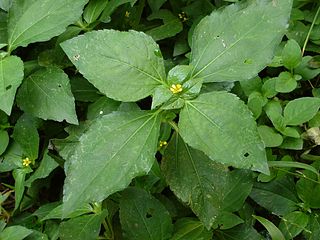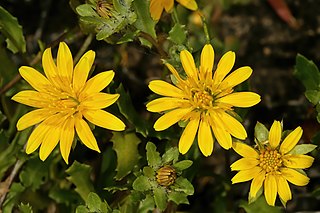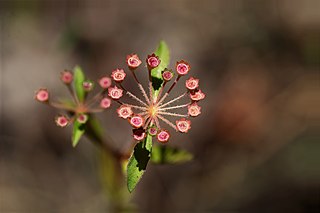
Antennaria is a genus of dioecious perennial herbs in the family Asteraceae, native to temperate regions of the Northern Hemisphere, with a few species in temperate southern South America; the highest species diversity is in North America. Common names include catsfoot or cat's-foot, pussytoes and everlasting.

Joseph Gaertner was a German botanist, best known for his work on seeds, De Fructibus et Seminibus Plantarum (1788-1792).

Xylomelum is a genus of six species of flowering plants, often commonly known as woody pears, in the family Proteaceae and are endemic to Australia. Plants in this genus are tall shrubs or small trees with leaves arranged in opposite pairs, relatively small flowers arranged in spike-like groups, and the fruit a woody, more or less pear-shaped follicle.

Gazania is a genus of flowering plants in the family Asteraceae, native to Southern Africa.

Talinum paniculatum is a succulent subshrub in the family Talinaceae that is native to much of North and South America, and the Caribbean countries. It is commonly known as fameflower, Jewels-of-Opar, or pink baby's-breath.

De Fructibus et Seminibus Plantarum, also known by its standard botanical abbreviation Fruct. Sem. Pl., is a three-volume botanic treatise by Joseph Gaertner. The first volume was published in December 1788. The second volume was published in four parts, in 1790, 1791, 1791 and 1792 respectively. A third volume was published after Gaertner's death by his son Karl Friedrich von Gaertner from 1805 to 1807; this final volume is also known as 'Supplementum Carpologicae', abbreviated as Suppl. Carp.. Most of the illustrations for the work were done by Johann Georg Sturm (1742-1793).

Pulicaria is a genus of flowering plant in the sunflower family, native to Europe, Asia, and Africa. In North America Pulicaria is known by the common name false fleabane.

Corymbia gummifera, commonly known as red bloodwood, is a species of tree, rarely a mallee, that is endemic to eastern Australia. It has rough, tessellated bark on the trunk and branches, lance-shaped adult leaves, flower buds in groups of seven, creamy white flowers and urn-shaped fruit.

Psydrax is a genus of flowering plants in the family Rubiaceae. It consists of trees, shrubs, and a few lianas in the paleotropics.

Eleusine is a genus of Asian, African, and South American plants in the grass family, sometimes called by the common name goosegrass. One species (Eleusine indica), is a widespread weed in many places. Another species Eleusine coracana, is finger millet, cultivated as a cereal grain in India and parts of Africa.

Aegiceras is a genus of trees and shrubs from Southeast Asia, Malesia, Australia and the Pacific Island,. and in Australia, in the Northern Territory, Queensland, New South Wales, and Western Australia. They occur as mangroves in coastal or estuarine areas.
Anaxeton is a genus of flowering plants in the family Asteraceae.
Ophiuros is a genus of Asia, Australian, and East African plants in the grass family.

Ursinia is a genus of African plants in the chamomile tribe within the daisy family. The genus is named in honor of German scholar Johannes Heinrich Ursinus 1608–1667.

Synedrella is a genus of flowering plants in the family Asteraceae.

Cuspidia is a genus of flowering plants in the family Asteraceae.

Arnoseris is a monotypic genus of flowering plants in the family Asteraceae.

Johann Georg Sturm (1742–1793) was a German natural history illustrator noted for the plates in Joseph Gaertner's De Fructibus et Seminibus Plantarum, and for co-authoring Deutschlands Flora in Abbildungen. He was the father of Jacob Sturm (1771–1848), a noted entomologist, who engraved the illustrations for the supplement to De Fructibus et Seminibus Plantarum.
Crepis zacintha, the striped hawksbeard, is a plant species native to southern Europe but now naturalized on roadsides and other disturbed sites in Texas, Israel, Cyprus, and the United Kingdom.

Pomax is a genus of flowering plants in the coffee family, Rubiaceae. Pomax umbellata, found in Australia, is the sole species of the genus. The genus was created in 1830, by the Swiss taxonomist Augustin Pyramus de Candolle, and published in his Prodromus Systematis Naturalis Regni Vegetabilis. Pomax umbellata was first described as Opercularia umbellata by Joseph Gaertner in 1788. but was transferred to the genus, Pomax by Daniel Solander in 1834.
















